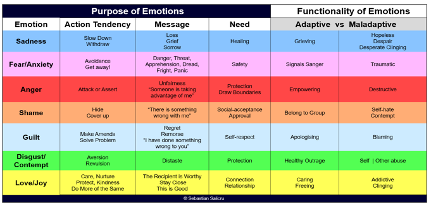Basic Emotions
Different researchers classify emotions slightly differently:
Paul Ekman’s most recent research (Ekman: 2011) identifies seven basic emotions (anger, surprise, disgust, enjoyment, fear, sadness and contempt); (initially his classification contained six basic emotions, in this work he added one more basic emotion – disgust).
Robert Plutchik (Plutchik: 1962) proposes eight basic emotions (anger, anticipation, joy, trust, fear, surprise, sadness and disgust), represented in his popular wheel of emotions.Researchers at the Institute of Neuroscience and Psychology at University of Glasgow identify four categories of emotions (happiness, sadness, fear/surprise, and disgust/anger).
Each primary emotion has a distinct purpose and functionality and can be either adaptive (healthy) or maladaptive (unhealthy), as depicted in the table below.
Characteristics of primary / basic emotions
The term “primary emotions” (Damasio, 1994, 131-134) refers to emotions which are supposed to be innate. They developed during human evolution to support fast and reactive response behavior in case of immediate danger, i.e. basic behavioral response tendencies like “flight-or-fight” behaviors.
From a neuroscientific point of view, they “depend on limbic circuitry, the amigdala and anterior cingulate being the prime players” (Damasio, 1994, 133).
So, primary (or basic) emotions are our most fundamental and direct initial reactions to an event or situation (e.g. experiencing sadness following a loss, or fear when perceiving a threat).
Primary emotions – characteristics:
- crucial for survival,
- functionally adaptive,
- innate and universal,
- distinct affective states,
- hardwired in our brains (don’t require learning).
Basic Emotions from Neuroscientific Perspective
Fear is a powerful emotion which plays an important role in survival – fight or flight response.
Many fMRI (Functional magnetic resonance imaging) studies support the hypothesis that amygdala is the most important hub in a fear reaction (LeDoux, 1998).
Several aspects of fear processing have been attributed to the amygdala:
- fear conditioning (Davis, 1992; LeDoux, 2007),
- initiation of fear-induced behaviors in response to stressors, (Weiskrantz, 1956; Blanchard and Blanchard, 1972; Prather et al., 2001; Izquierdo et al, 2005; Machado et al, 2009),
- memory creation of fear-related stimuli (Cahill et al, 1995; Hamann, 2001).

Anger can be a particularly powerful emotion, characterized by feelings of hostility, agitation, frustration, and antagonism towards others.
Like fear, anger can play a part in your body’s fight or flight response.
Orbitofrontal cortex is the location for anger, because of its relation to prey.
Many fMRI studies suggest that the interaction between orbitofrontal cortex and amygdala is involved in the regulation of anger (Coccaro et al, 2007; Fulwiler et al, 2012).
Amygdala activity is related to initiation of fear, while the orbitofrontal cortex is involved in the fear extinction (Milad and Rauch, 2007; Siep et al, 2018).

Sadness: is an emotion caused by loss and helplessness (Motoki, Sugiura, 2018), or it is related to failure to get wanted thing (reward), or punishment to get harmful things (Gu et al, 2016).
Anterior cingulate cortex (ACC) is related to sadness (Godlewska et al., 2018; Ramirez-Mahaluf et al, 2018a,b). ACC is also linked to sadness because of its role in suffering; many studies have suggested that ACC is also involved in pain or suffering feeling and depression (Taylor et al, 2018).

The meaning of human life is associated to a large extent with the pursuit of happiness.
There are two different conceptions of happiness: hedonic happiness and eudaimonic happiness (Simeng Gu et al, 2019).
- Hedonic happiness is related to physical or psychological pleasure.
- Eudaimonic happiness is related to reaching personal goals or to expressing our potential, our abilities. (Berridge, Kringelbach, 2011).
Happy events from both kinds activate the ventral prefrontal cortex (including orbitofrontal cortex) (Kringelbach, 2005).
In a functional magnetic resonance imaging (fMRI) experiment, Rolls et al. (2008) found that activations in the ventral prefrontal cortex, the cingulate cortex, and the ventral striatum were associated with the positive hedonic state.

The emotion of disgust is typically experienced as a feeling of revulsion elicited by offensive stimulations, either in physical or moral respect.
There is no consensus among neuroscientists concerning the brain region responsible for disgust processing, as well as about the nature of this emotion itself.
Some researchers defend the opinion that the insula is the location of disgust processing and that it differs from anger and fear, while others, on the basis of meta-analysis of imaging data, found that the anterior insula is not more active during disgust processing than when processing other emotions, such as anger (Wager et al, 2007; Oaten et al, 2018a,b).

The surprise emotion alerts the individual of any deviations from expectations, regardless of the outcome value (Litt et al, 2011; Fouragnan et al, 2018).
According to meta-analyses of fMRI studies, surprise induced brain regions are predominantly subcortical, including the amygdala and striatum, as well as some cortical regions, such as the ventromedial prefrontal cortex and the cingulate cortex (Behrens et al, 2009; Bartra et al, 2013).



